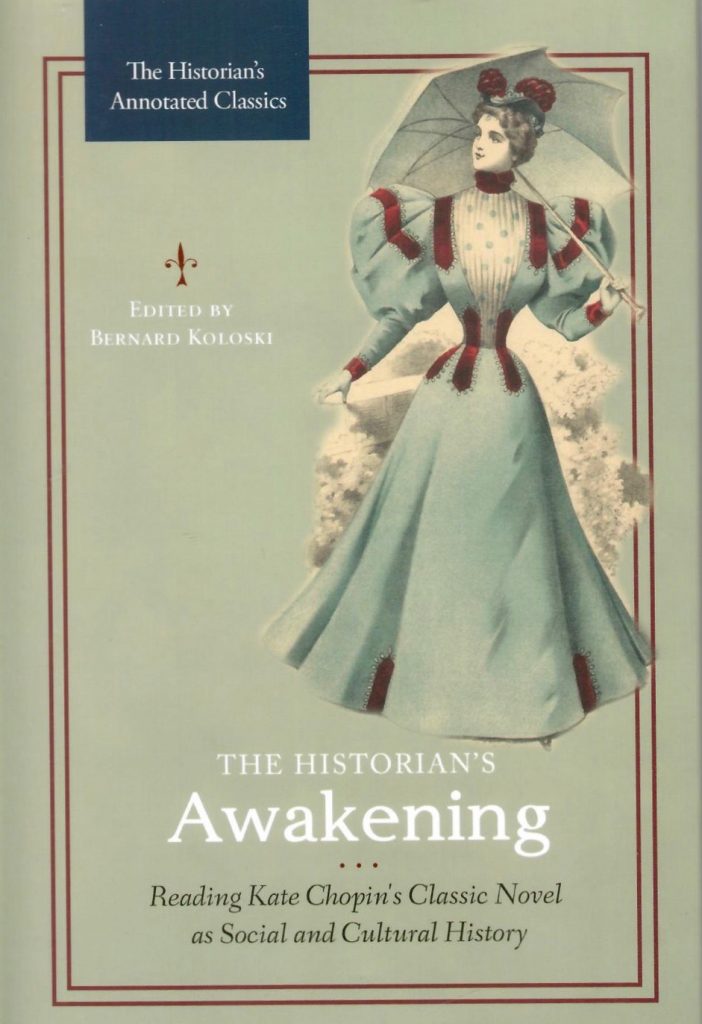The Awakening is Kate Chopin’s novel about a married woman seeking greater personal freedom and a more fulfilling life. Condemned as morbid, vulgar, and disagreeable when it appeared in 1899, it is today acclaimed as an essential American book.
By the Editors of KateChopin.org
Read The Awakening online
New Kate Chopin’s popularity
A YouTube interview about the novel
Characters
How to pronounce characters’ names
Time and place
Themes
When the novel was written and published
What critics and scholars say
Questions and answers
The Awakening as social and cultural history
The 2018 Norton Critical Edition of The Awakening
New A 2025 Velshi Banned Book Club broadcast: The Awakening
Translations
A question about first editions
Films
A dance production
A 2016 theatre production
A 2021 theatre production
Barbara Kingsolver on The Awakening
Accurate printed texts
Articles and book chapters about the novel
Books that discuss the novel
“The Awakening and American Libraries“
Reading Kate Chopin’s The Awakening online and in print
You can read the novel in our online text, which is based on a first edition of the novel (Herbert S. Stone & Company, 1899) in the Harvard University library. After the last chapter of the novel, you can read about small corrections made in this online text.
You should be able to read the text easily on a computer, a tablet, or a smartphone. You can search it or print it. If you find an issue with it, would you please contact us?
In print you can find the novel in these publications:
The Historian’s Awakening: Reading Kate Chopin’s Classic Novel as Social and Cultural History. Edited by Bernard Koloski. Praeger, 2019.
The Norton Critical Edition of The Awakening. Edited by Margo Culley. Norton, third edition, 2018.
The Complete Works of Kate Chopin. Edited by Per Seyersted. Baton Rouge: Louisiana State University Press, 1969, 2006.
Kate Chopin: Complete Novels and Stories. Edited by Sandra Gilbert. New York: Library of America, 2002.
Kate Chopin, The Awakening and Selected Stories. Edited by Sandra Gilbert. Penguin 1984.
There are also many paperback editions of the novel available today. Several include background readings, critical comments, bibliographies of scholarly articles and books, Chopin short stories, and other materials. For publication information about these books, see the section “For students and scholars” near the bottom of this page.
The Awakening characters
- Edna Pontellier
- Léonce Pontellier: husband of Edna
- Etienne and Raoul Pontellier: children of Edna and Léonce
- A quadroon who cares for Etienne and Raoul
- Madame Aline Lebrun: owner of a pension on Grand Isle
- Robert Lebrun: son of Madame Lebrun
- Victor Lebrun: brother of Robert Lebrun
- Mariequita: woman of Spanish descent who lives on Grand Isle
- Adèle Ratignolle: guest at the pension on Grand Isle
- Alphonse Ratignolle: pharmacist, husband of Adèle
- Mademoiselle Reisz: pianist, guest at the pension on Grand Isle
- Others on Grand Isle: two lovers, a lady in black, the Farival twins, old Monsieur Farival, Beaudelet. . . .
- Madame Antoine: woman of Chênière Caminada across the bay from Grand Isle
- Toni: son of Madame Antoine; he and his mother appear in the Chopin short story “At Chênière Caminada”
- Old Celestine, Ellen, Joe, and other servants in the Pontellier’s house in New Orleans
- Doctor Mandelet: the Pontelliers’ physician
- Edna’s father: former colonel in the Confederate army
- Alcée Arobin: young man of fashion in New Orleans
- Mrs. Highcamp: friend of Alcée Arobin
- James Highcamp: husband of Mrs. Highcamp; the Highcamp’s daughter
- Mrs. Merriman and Miss Mayblunt: guests at Edna’s part in Chapter XXX of the novel
- Gouvernail: journalist, also a guest at the party. In French his name means a rudder, a tiller, with the implication that he is someone who knows the direction, who understands where things are headed. He plays a central role in the Chopin stories “A Respectable Woman” and “Athénaîse”
- Madame Pontellier: mother of Léonce
How to pronounce characters’ names
If you want to pronounce Edna Pontellier — and the French names of other characters — as Kate Chopin herself probably pronounced them, you could check this pronounciation guide.
The Awakening time and place
The Awakening is set in the late nineteenth century on Grand Isle, off the coast of Louisiana; on the island Chênière Caminada across the bay from Grand Isle (the island was destroyed in an 1893 hurricane); and in the city of New Orleans. It begins on Grand Isle, shifts to New Orleans, and concludes on Grand Isle.
The Awakening themes
Readers and scholars have been discussing the novel’s themes for a hundred years, and their views vary widely. Early critics condemned the book for its amoral treatment of adultery, and some readers today share that view. But from the 1960s on, most scholars and readers in the USA and many other nations have come to think of Kate Chopin as “the first woman writer in her country to accept passion as a legitimate subject for serious, outspoken fiction,” to cite the words of Per Seyersted, and they see Chopin as one of America’s essential authors. The closing chapter in the recent Cambridge Companion to Kate Chopin describes the full range of ideas people have found in the novel since its publication. You can also read about themes in Kate Chopin’s stories and novels on the Themes page of this site.
When Kate Chopin’s The Awakening was written and published
The novel was begun in 1897 and completed on January 21, 1898. Kate Chopin’s original title was A Solitary Soul. It was published as The Awakening by Herbert S. Stone & Company in Chicago on April 22, 1899. The title page:
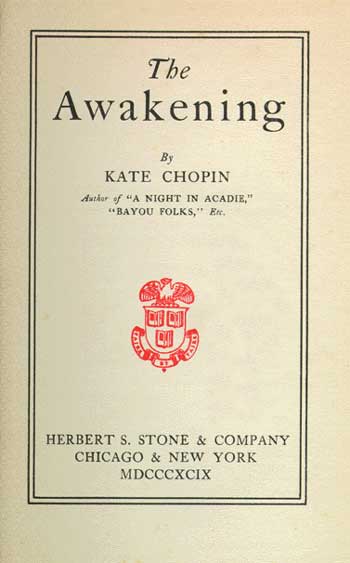
You can find complete composition dates and publication dates for Chopin’s works on pages 1003 to 1032 of The Complete Works of Kate Chopin, edited by Per Seyersted (Baton Rouge: Louisiana State University Press, 1969, 2006).
What critics and scholars say about The Awakening.
An enormous amount has been written about the novel for many years. Some representative comments:
Per Seyersted writing in 1969, near the beginning of the literary revival that propelled The Awakening into its present place of importance in American literature, noted that part of what makes the novel feel so modern is Edna Pontellier’s realization that “the physical component of love can stand apart from the spiritual one, that sensuous attraction is impersonal and can be satisfied by a partner she does not love.”
“Chopin’s sense of a complex reality,” Barbara C. Ewell writes, “permits no easy answers to the moral questions raised by [the] conflict between the individual and social restraints. Instead, by withholding the moral of this moralistic tale and leaving the nature and value of Edna’s awakening essentially unresolved, Chopin delineates the difficulty of calibrating the appropriate relationship between the self and society.”
In one of the best-known essays about the novel, Sandra Gilbert argues that “metaphorically speaking, Edna has become Aphrodite [the Greek goddess of love], or at least a devotee of that goddess. But what can be — must be — her fate?” Kate Chopin, Gilbert argues, examines “the difficulty of the struggles for autonomy that she imagines would have engaged any nineteenth-century woman who experienced such a fantastic transformation. If Aphrodite . . . were reborn as a fin de siècle [close of the nineteenth century] New Orleans housewife, says Chopin, Edna Pontellier’s fate would be her fate.”
Sandra Gilbert and her coauthor, Susan Gubar in their study The Madwoman in the Attic: The Woman Writer and the Nineteenth-Century Literary Imagination (1979), Bonnie James Shaker writes, “have been called ‘revolutionary’ and ‘groundbreaking’ for their part in the movement to forge a women’s literary tradition from the countless female-authored texts that had been excised from the study of literary history, theory, and criticism. Together, they launched nothing short of a female literary canon. So successful were the coauthors in making women’s texts available for reading, teaching, and discussing by collecting them in print and developing ways to think about a distinctly female literary trajectory that today’s students might reasonably doubt there was ever a time when we did not study women’s writing.”
Other scholars and critics have approached The Awakening in other ways.
“A contemporary reader,” Nina Baym writes, “may well be inclined to understand Edna’s sexual emancipation as a feminist issue. But such a reading would be somewhat anachronistic.” Because, Baym adds, of the “relatively crude forms of birth control and the enormous risks of childbearing in those days—every act of sexual intercourse was, for a woman, a literally life-endangering act.” Progressive women in Kate Chopin’s day, she concludes, “were more likely to perceive sexual freedom as being freedom from sex rather than freedom through sex. What they wanted for women was the right to say no, rather than the right to say yes whenever and wherever they pleased.”
Elizabeth Fox-Genovese notes that Chopin weaves two narrative threads together in her novel: the “institutional and personal voices.” These voices, she says, necessarily critique each other. Chopin “was not likely to let a searching critique lead her to conclude that the social order of the bourgeois South required the institutional subordination of women. Nor would she have been comfortable with the view that the freedom of women dictated the substantial reform of the prevailing social institutions.”
The power of The Awakening, Cynthia Griffin Wolff writes in an influential essay, “derives from its ruthless fidelity to the disintegration of Edna’s character. Edna . . . interests us not because she is ‘a woman,’ the implication being that her experience is principally important because it might stand for that of any other woman. Quite the contrary: she interests us because she is human — because she fails in ways which beckon seductively to all of us.” Edna, she adds, “is very little open to sustained emotional relationships.” She thinks of Edna as having a “schizoid personality.”
Donald Pizer, pointing out that Chopin read authors such as Charles Darwin, examines Edna Pontellier’s struggles within the context of nineteenth century naturalist fiction. He argues that the novel, and Edna’s struggle, cannot be separated from their “participation in the naturalistic belief that the human will is often deeply circumscribed by the inseparability of the lives of men and woman from the natural and social worlds they inhabit.”
Drawing on the work of Karl Marx and Frederick Engels, John Carlos Rowe contends Kate Chopin recognized that “love in this culture is simply another word for warfare. . . . Certainly Chopin’s redefinition of love, suggested obliquely in Edna’s brief moments of confidence with Mlle. Reisz and Adèle, must be understood in terms of Edna’s (or any subject’s) ability to work and thus contribute to social value.”
Hugh Dawson argues that the novel “has been misappreciated,” that “the book does not deserve the high place now accorded it.” Unlike most modern critics, he argues that Edna is not “a truly compelling character,” that she fails on an ethical level due to her extreme self-serving nature. “She seems to be willing to die for herself rather than to live for her children,” he argues. “The choices she makes give no evidence that she appreciates the obligations she has assumed or considers the available alternatives.”
Reading the novel in its historical context, Bernard Koloski writes that “although Edna’s struggle is in part personal, it is in better part social and cultural. It is defined by the conventions of upper-class people in the 1880s and 1890s. It is intensified by obligations imposed upon wealthy women. It is set in motion by differences in ethnicity — by Edna’s emotional interactions with several Creoles. And it results in a severe discontent that often haunts people in modern societies.”
Heather Ostman, focusing on Catholicism in Chopin’s short stories and novels, argues that “Chopin sets up a dichotomy between Catholic representations and Edna Pontellier’s developing consciousness of the spiritual self, and she presents a feminine spirituality, independent of the Church and a challenge to its authority.”
You can search the titles in our extensive databases of books and articles for more information about The Awakening — information in English, German, Portuguese, and Spanish.
Questions and answers about The Awakening
Q: I’m a teacher and would like help with the pronunciation of French names in The Awakening. Can you tell me how to pronounce the more common names?
A: Our pronunciation page explains how to deal with characters’ names.
Q: How old is Edna Pontellier?
A: She is twenty-eight, according to Chapter VI in the novel.
Q: Is Edna a Creole?
A: No. But her husband is, and she is living among Creoles on Grand Isle and in New Orleans. She is a Kentucky and Mississippi Presbyterian.
Q: Why are there so many French expressions in the novel? If I don’t understand French, how do I know what those expressions mean?
A: There are a couple of ways to think about this.
It’s simply a fact that many people with French and Spanish roots lived in Louisiana when Kate Chopin lived there, and some of them spoke more than one language. Several of the characters in The Awakening speak French, Spanish, Creole, or all three, in addition to English. Like Mark Twain and other writers of her time, Chopin was determined to be accurate in the way she recorded the speech of the characters she focused on in her work.
But it may be helpful to recognize that Edna Pontellier herself understands French and French culture imperfectly. She has only, as the novel points out in Chapter 2, “a small infusion of French which seemed to have been lost in dilution.” She is not a Creole. She is not from Louisiana and did not grow up a Roman Catholic. She is out of her Kentucky or Mississippi Presbyterian environment, out of her native element. So to some extent your puzzlement over those French expressions may be similar to hers. There are suggestions in the novel that at times Edna is not fully aware of what’s going on around her.
A few editions of The Awakening include translations of French expressions, and Chopin usually subtly makes clear the meaning of such expressions in the text. Not understanding a French phrase is unlikely to lead to a mistake in understanding the novel.
Q: I was upset seeing words like “negroes” and “darkies”in this story. Why did Chopin include them?
A: This requires a sense of historical empathy, recognizing that the novel was written in a different time from our own. Chopin’s language here is a picture of the way people in her time spoke to one another. Words like “darkey” and “Negro,” offensive for us in the twenty-first century, were used familiarly by people of color and white people in Chopin’s Louisiana, often without intended rancor. Kate Chopin reproduced such language in her characters’ speech, as she reproduced people’s dialectal patterns. For her, as for Mark Twain and others of her generation, recording accurately the way people spoke was an important part of being a good writer.
Louisiana at the time was just a decade or so away from slavery. Chopin does not pretend that the color line is gone, that African Americans enjoy complete freedom and equality, or that everyone lives in racial harmony with everyone else. There are racial tensions in several of her short stories.
Chopin was, of course, a nineteenth-century, white, Southern, American woman, but she was also deeply steeped in French culture, being bilingual and bi-cultural from birth. She shares both American and European attitudes toward race, and she always sees more than her characters do.
As we note on other pages of this site, there’s been a good deal written about Chopin and race. If you want to explore the subject you might start by reading articles by Anna Shannon Elfenbein, Helen Taylor, and Elizabeth Ammons in the Norton Critical Edition of The Awakening, and you might look at Bonnie James Shaker’s Coloring Locals. For a defense of Chopin you might start by checking Emily Toth’s Kate Chopin and Bernard Koloski’s Kate Chopin: A Study of the Short Fiction, and on line you could read Elizabeth Fox-Genovese’s comments on the Kate Chopin: A Re-Awakening site. You can find information about these and other publications about Chopin and race at the bottom of the Awakening page and the Short Stories page of this site, as well as on pages devoted to individual stories, like “Désirée’s Baby.”
Q: I’m confused about Kate Chopin’s phrasing in Chapter 27 of the novel. Does Edna Pontellier really have sex with Alcée Arobin?
A: Yes. The language in Chapter 27 reflects literary conventions of the 1890s. Kate Chopin almost certainly would not have found a publisher for the novel if she had included more sexually explicit phrasing. Some readers have wondered about the phrasing in “The Storm,” asking why Chopin was able to describe sex so directly in that short story. The answer is that she did not try to publish the story. There is no record that she sent the manuscript to any publsher. “The Storm” did not appear in print until sixty-five years after her death.
Q: How many times (and where) did Alcée and Edna consummate their love?
A: There was no love involved (explained in Chapter 28). The text shows that Edna and Alcée have sex in the house on Esplanade Street (in Chapter 27), after the party when they go to the pigeon-house (in Chapter 31) and, apparently, in Chapter 35.
Q: In Chapter 30 of the novel a character named Gouvernail mutters two lines of poetry. Do you know where they came from?
A: Yes–and Gouvernail also quotes lines of poetry in Chopin’s short story, “A Respectable Woman.” The lines in this novel are from a sonnet titled “A Cameo” by Algernon Charles Swinburne:
There was a graven image of Desire
Painted with red blood on a ground of gold
Passing between the young men and the old,
And by him Pain, whose body shone like fire,
And Pleasure with gaunt hands that grasped their hire.
Of his left wrist, with fingers clenched and cold,
The insatiable Satiety kept hold,
Walking with feet unshod that pashed the mire.
The senses and the sorrows and the sins,
And the strange loves that suck the breasts of Hate
Till lips and teeth bite in their sharp indenture,
Followed like beasts with flap of wings and fins.
Death stood aloof behind a gaping grate,
Upon whose lock was written Peradventure.
As we explain above, Gouvernail’s name in French means a rudder, a tiller, with the implication that he is someone who knows the direction, who understands where things are headed. His quoting the lines of Swinburne’s sonnet suggests that he senses a figure of death at Edna’s party.
Q: In Chapter 22, what does Dr. Mandelet mean when he asks Léonce Pontellier if Edna has “been associating of late with a circle of pseudo‑intellectual women‑‑super‑spiritual superior beings? My wife has been telling me about them”?
A: He’s most likely referring to the spiritualism movement, which was popular in the United States at the time Kate Chopin was writing the novel. Kathleen Butterly Nigro, an American English professor, notes that people involved in the movement believed “that through the use of a medium, they would be able to tap into the energy of people who had died.” The rise of spiritualism coincided with the end of the Civil War, which killed more than 750,000 Americans. “Because so many people had died in the war,” Nigro says, “the notion that individuals could possibly stay in contact with people they had lost was very appealing.”
New Q: Is there any critical evidence that shows Edna and Adèle have a sexual relationship? In chapter VII, the narrator states that Edna has a “sensuous susceptibility” to Adèle’s beauty and notes that there’s a subtle bond “which we call sympathy, which we might as well call love.” Is this a friendly relationship, or is this another “Awakening” for Edna (in addition to Robert and Alcée)?
A: Kate Chopin scholars respond:
Thomas Bonner (Xavier University of Louisiana): No, but more of a mother-daughter relationship. In the French society of 19th-century New Orleans, there was a warmth of expression among women who were close friends.
Barbara Ewell (Loyola University of New Orleans): Some critics, notably Kathryn Lee Seidel (check the last book in the listing) and Elizabeth LeBlanc (check articles from 1996) have noted the homoerotic undertones in the novel, both with Mademoiselle Reisz and with Adèle Ratignolle. In the context of 19th century expressions of friendship between women, these passages don’t necessarily imply sexual intimacy, and there is no clear textual evidence for such, but the possibilities for “another awakening” are intriguing and do add an interesting dimension to the text.
Bonnie James Shaker (Kent State University at Geauga): To add to Tom and Barbara’s comments: I am reminded of Caroll Smith-Rosenberg’s “The Female World of Love and Ritual.” As an old article, it has since been critiqued. Still, it remains among the best I have found explaining privileged white women’s intimate friendships in the nineteenth century.
Eulalia Piñero Gil (Universidad Autónoma de Madrid, Spain): I agree with my colleagues’ comments. I don’t really see a sexual relationship. I know the novel in two languages and when I was translating it into Spanish, I rapidly perceived the subtle sexual innuendos in Edna’s relationship with Alcée and Robert. Whereas in the case of her relationship with Adèle and Mademoiselle Reisz, what I interpret is just a very close female bonding: affection, attachment, friendship, cooperation.
Q: I am sure that when I was in college, my professor told me that in Chapter 13 — when Edna is resting at Madame Antoine’s house — she masturbated. I cannot find this anywhere in research about the book. Can you confirm this? Isn’t it true that this was one of the reasons The Awakening was not widely accepted in Chopin’s time? That’s the impression I have.
A: Second question first: So far as we can tell, all comments about The Awakening published in Chopin’s lifetime are widely available, and all have been discussed by scholars, teachers, students, and others for decades. Nothing in any of those comments mentions the possibility of a masturbation incident in the book. It is clear that masturbation was not one of the reasons the book was attacked by critics in the 1890s.
About the first question, here is what two Chopin scholars have to say:
Emily Toth: A lot of people teach as fact that when Edna massages her arms and admires them at Madame Antoine’s, she’s masturbating. I don’t see it that way. I think it’s admiration, maybe narcissism. I’ve never seen anything about it in print, and personally I don’t think it’s a useful interpretation. As Freud allegedly said, “Sometimes a cigar is just a cigar.” I’ll add what I say: “Sometimes an arm is just — an arm.”
Thomas Bonner, Jr.: This is a gross misreading by the letter writer’s professor. Even if the professor is using the word “masturbating” metaphorically, it is still a distorted reading. I have run into no articles citing masturbation and Chopin. One of the real problems with many readers today is the imposition of twenty-first century sensibilities on a nineteenth-century author’s work.
Q: I have been translating The Awakening into the Persian language, as it hasn’t yet been translated. The translation is a somewhat slow, but very joyful adventure so far. However, I have difficulty understanding a paragraph from chapter 17, where the novel describes a “Reception Day.” I am somehow failing to understand the rationale behind these receptions, as it says they have been having them every Tuesday during the last six years. I came across this website and I thought maybe I can get some help here.
A: Several Kate Chopin scholars respond.
David Z. Wehner: If you were married to a man who is part of the upper-middle class or upper class in American culture, it was expected that one afternoon a week, say Tuesday, you would have a reception day, say, from 2:00–4:00 in the afternoon. The wife of the couple (Edna) would announce her reception day, and then the wives of other couples of a similar social station would stop by in the allotted time. They would leave their card with the butler or on a tray in the foyer. They would stay for a bit, have tea and cake, converse about the weather, and then leave.
Etiquette required that the next day, the hostess would write each of her guests saying how wonderful it was to see them, and each guest would write a thank-you note saying how wonderful it was to see the hostess. So when Edna says “no” to this practice, she is saying no to the mind-numbing superficiality of this bourgeois piece of etiquette meant to secure one’s social standing.
Kathleen Butterly Nigro: I think the translator may be confused by the tradition of the set day of the week during which a women was required to accept visitors. To refuse to do so or to be away from home was a serious breach of etiquette. What might help is to understand the etiquette of the calling card.
Thomas Bonner, Jr: “At Home Day” was (and in places still is) the term for this social practice in England. In its colonies, officials, military and naval officers, and their wives practiced this custom as well. I would think that there might be vestiges of this among the higher classes in Afghanistan, Pakistan, and India.
In New Orleans, Creole society had such a strong interest in business that the practice essentially had multiple purposes, supporting the associations among the class and providing good customer and business relations for the husband — the reason Léonce was so concerned when Edna relaxed this practice.
In New Orleans, the antique shops still offer the small silver trays that were used for collecting the engraved cards.
Emily Toth: I agree for the most part with what others have posted, including the term “At Home,” although I wonder if that had a French term in New Orleans. It would be chez moi or chez nous now, but then?
The one difference I have is this: the calling day (reception day) was for women to visit women, in the afternoons. Husbands were not generally involved. The idea was that the wife of a prominent man (like Léonce Pontellier) would make friends with the wives of his business associates, and that would be helpful for his business.
The wives, as Chopin shows, were not consulted, just expected to do this. And if a wife didn’t do it, as Edna doesn’t, she was considered to be a bad wife.
Chopin wrote The Awakening in St. Louis in the 1890s, and there the calling/visiting might take place at night, husbands involved. That’s in Kate Chopin’s 1894 diary, reprinted in my Kate Chopin’s Private Papers and also discussed in my biography, Unveiling Kate Chopin. Her reception evening was a “salon,” following the French custom of both sexes visiting.
That may be why and how Kate Chopin decided to have Edna violate the visiting rules of her society. Chopin did, too.
Tom: Like Emily, I wondered about the French in New Orleans. The social practice actually began in France in the 17th century. The cards were called une carte d’adresse, and by the 19th century une carte de visite (or visiteur). The social etiquette spread across Europe, but became strong especially in Britain.
There was, as Judith Bonner noted, almost “a language” in the practice of leaving and responding to the cards. For example, if the card had an edge turned up, it was delivered by the person, and if it were flat, it would have been delivered by a servant. Even the arrangement of the received cards suggested a hierarchy. A term for the tray in which they were placed is silver salver — in households of lesser means a china tray was used. Judith said that The Historic New Orleans Collection has a painting of a lady preparing for an afternoon call. The strong British influence north across Lake Pontchartrain from New Orleans and west toward Baton Rouge as well as in New Orleans’ Garden District (with Americans of Anglo-Saxon descent) just up the Mississippi from the French Quarter likely reinforced the tradition in New Orleans.
Dave: With my students in Denver, Colorado, I once toured the Molly Brown House, as in The Unsinkable Molly Brown, as in Titanic. Molly Brown had the silver tray in the foyer and adhered to this practice. This social custom made it as far west as Denver.
Question from Mary Mahoney: Do you know the rest of the words and the melody of “Si tu savais,” the song that appears in Chapters 14 and 19 of the novel and then again in the party scene in Chapter 30? Is it a real song, or did Kate Chopin make it up?
A: We posed this question to Chopin scholars Emily Toth and Thomas Bonner, Jr. Their responses:
Emily Toth: It’s a real song, written by Michael William Balfe, an Irish composer of art songs. It seems the song was written about 1859. There is online a Balfe fan site and the sheet music for the song.
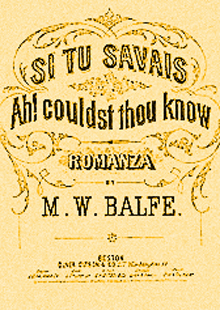
Thomas Bonner, Jr.: Interesting connection, but, except for the refrain, the lyrics are different from those in the novel. Apparently, the phrase “Ah, si tu savais” was and is used widely in lyrics. Is it possible that Chopin heard the Balfe song performed and simply recalled it imperfectly? Or purposely amended the lyrics to reflect her multiple uses of “eyes” in her descriptions? A puzzle.
Jenny Lind and Adelina Patti both sang Balfe songs and arias; the singers visited New Orleans well before Chopin arrived, but they were so popular in the city — and nationally — that the music they sang at the French Opera House was likely picked up by local and other visiting singers. These singers also performed in St. Louis. And so Chopin could have heard the lyrics, remembered the key phrase, and used it.
Emily Toth: This seems most likely to me.
Response from Mary Mahoney: I believe Balfe also wrote “Come into the garden Maude” and “I dreamt I dwelt in marble halls”. Both those were popular in Britain, when I was a child in the ‘thirties. I heard them on the radio in the “Music Hall” (i.e. Variety) broadcasts. A holdover from Victorian days I think. Ah well, that was a long time ago.
Q: Was Kate Chopin involved in the women’s suffrage movement, in the progressive movements for educational reform, health care reform, or sanitation improvement? Was she involved in any other historically significant happenings of her time?
A: Kate Chopin was an artist, a writer of fiction, and like many artists — in the nineteenth century and today — she considered that her primary responsibility to people was showing them the truth about life as she understood it.
If you’re asking if Kate Chopin was involved in social activism as political scientists today would understand that term, the answer is no. She was not a social reformer. Her goal was not to change the world but to describe it accurately, to show people the truth about the lives of women and men in the nineteenth-century America she knew.
If, however, you’re asking if Chopin was involved in “historically significant happenings” as many artists would understand those words, then the answer is yes. She was among the first American authors to write truthfully about women’s hidden lives, about women’s sexuality, and about some of the complexities and contradictions in women’s relationships with their husbands.
As the critic Per Seyersted phrases it, Kate Chopin “broke new ground in American literature. She was the first woman writer in her country to accept passion as a legitimate subject for serious, outspoken fiction. Revolting against tradition and authority; with a daring which we can hardy fathom today; with an uncompromising honesty and no trace of sensationalism, she undertook to give the unsparing truth about woman’s submerged life. She was something of a pioneer in the amoral treatment of sexuality, of divorce, and of woman’s urge for an existential authenticity. She is in many respects a modern writer, particularly in her awareness of the complexities of truth and the complications of freedom.”
Artists like Kate Chopin see the truth and help others to see it. Once people are able to recognize the truth, then they can create social reform movements and set out to correct wrongs and injustices.
Q: I read on a blog that Kate Chopin “was an integral part of the evolution of feminism, providing early 20th century readers with feminist literature that is still highly respected and studied today.” Is that true?
A: No, it’s almost certainly not true, simply because, from everything we can tell, little of what many readers today consider Chopin’s feminist literature was read in the early years of the twentieth century — The Awakening, for example, or “The Story of an Hour,” or, certainly, “The Storm.” You might argue that after the 1960s or 1970s Chopin became “an integral part of the evolution of feminism,” but she probably had little or no influence on early 20th-century feminist readers.
Q: Have other writers focused works on women’s experience, on a woman’s awakening?
A; Yes, many have. Critic Susan Rosowski reminds us that fairy tales like “Snow White,” “The Little Mermaid,” and “Sleeping Beauty” are about female development, as are novels like Gustave Flaubert’s Madame Bovary, Willa Cather’s My Mortal Enemy, and Margaret Atwood’s Lady Oracle. Rosowski considers The Awakening a prototype of the novel of awakening.
Q: Do critics ever write about clothing and fashion in The Awakening? It seems to me it’s an important matter.
A: Yes, that subject has often come up. Emily Toth, for one, writes that throughout the novel “Edna sheds more and more veils, physically and spiritually, until at the end, she is naked.” And Katherine Joslin discusses clothing at length in “Kate Chopin on fashion in a Darwinian world,” an essay in the Cambridge Companion to Kate Chopin.
Q: Was Chopin’s The Awakening forgotten until her literary revival in the 1970s?
A: Yes, in general it was forgotten, although a few people in Europe and the United States were familiar with the book throughout the first half of the twentieth century. Some of Chopin’s short stories, however, were not forgotten. Several of those stories appeared in an anthology within five years after her death, others were reprinted over the years, and scholars began writing about her fiction a decade or so before it caught fire with the appearance of her Complete Works in 1969.
Q: Was The Awakening really banned from libraries in Chopin’s hometown of St. Louis?
A: Not so far as we can tell. Emily Toth, Chopin’s biographer, tried to verify that claim — one that has been repeated for decades — but could find no evidence to support it. But it is true that The New York Times on July 6, 1902, reported that the Evanston, Illinois, Public Library had removed from its open shelves The Awakening and other books that the library board found objectionable (the article is on p. 9 of the newspaper). And the 2011 Banned or Challenged Books site sponsored by The American Library Association and other groups notes that the novel was “challenged at the Oconee County, Ga. Library (2011) because the cover of the book — a novel about a woman whose desires run against the family structure of the 1890s — shows a painting of a woman’s bare chest and upset the patron.”
Charles Johanningsmeier (University of Nebraska at Omaha) has published an important article showing that trying to understand if The Awakening was banned at other places is very complex.
In his article, Johanningsmeier explains that he has been “investigating how American public libraries, and specifically those who ran them, actually dealt with a wide variety of works by realist and naturalist authors between 1880 and 1914.” He describes how he had examined data (finding lists and catalogs) at eighty American public libraries to see how the library staff had dealt with The Awakening and other fiction at the turn of the twentieth century. His conclusion:
“The new information related here does highlight . . . how important it is to continue examining long-held beliefs about the role libraries played in making texts available — or not available — to American readers in late nineteenth and early twentieth centuries. In the cases of other works of boundary-pushing fictions such as Maggie: A Girl of the Streets, Rose of Dutcher’s Coolly, and The Damnation of Theron Ware, I have found that a surprisingly large number of librarians — chiefly from larger towns and cities — courageously purchased them and made them available to patrons, despite the likelihood of encountering community resistance. With The Awakening, unfortunately, there were many more librarians who chose to take the safer option of not adding it to their collections.” Read more.
Q: Do you know why Kate Chopin’s original title for the novel, A Solitary Soul, was changed to The Awakening and how the change affected the success of the book?
A: Sorry, but we know of no explanation for who changed the title or why. A rumor in an 1899 St. Louis newspaper review suggests that the publisher changed it. If that’s true, it may have been for many reasons. And we know of no way that someone could determine how the title change may have affected the novel’s success in 1899 or since.
Q: I haven’t been able to find the number of pages in the Herbert S. Stone and Company first edition of The Awakening in 1899. I would like to know how many pages it has.
A: It has 303 pages. You can verify that by checking the rare book area of some libraries, like the library at the Missouri History Museum in St. Louis, Missouri, USA. And on Google Preview you can see a photocopy of the book itself and be able to scroll down to p. 303..
Q: Has The Awakening been translated into other languages?
A: Yes. It appeared in a French translation by Cyrille Arnavon in 1952.
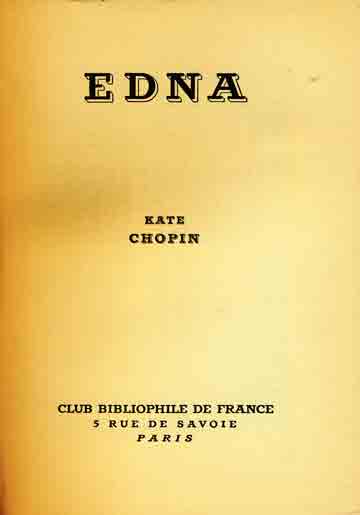
That edition has illustrations by André Hubert. Here’s Edna and Robert:
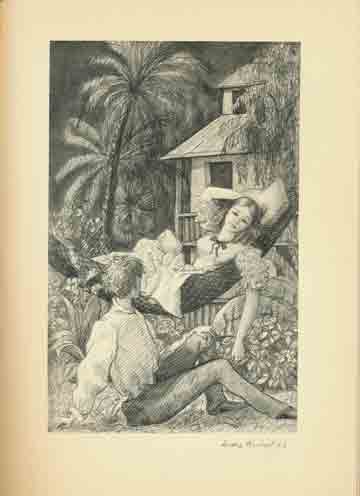
And here is the first page of the 1952 French translation:
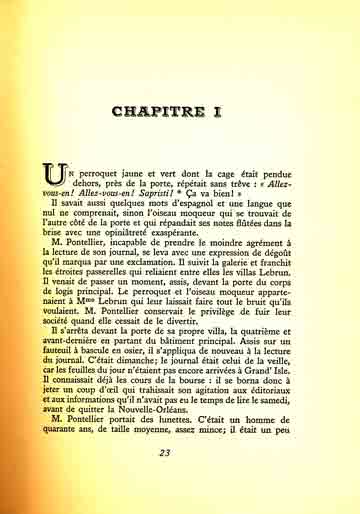
The Awakening has also been translated again into French and into many other languages. You can see which languages and look at some book covers on our Translations page.
Q: Has The Awakening been made into a film? I can’t find such a film anywhere.
A: Yes, there are at least two versions. In 1991, Mary Lambert directed the made-for-cable Grand Isle, with Kelly McGillis playing Edna Pontellier. The film is not, apparently, available on DVD.
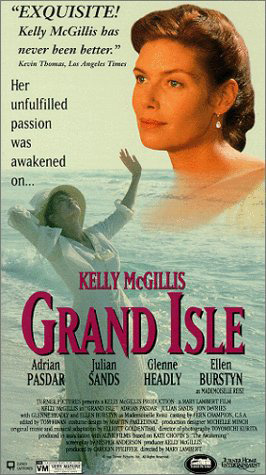
Also, earlier, in 1982, director Bob Graham did a feature-length version of the novel called The End of August. It’s apparently no longer easily available, but you may be able to find a VHS copy:
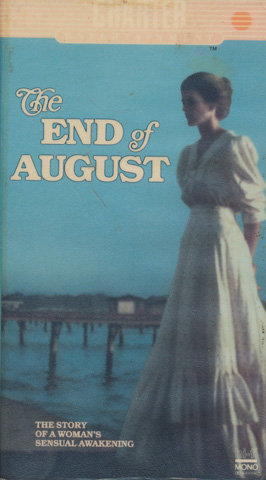
IMDb.com, the Internet Movie Database, includes a filmography of works based on Kate Chopin’s fiction. The listing includes nine films–long and short–made between 1956 and 2014.
There is, in addition, what many critics consider a fine novel by Robert Stone called Children of Light, about a production company making a film of The Awakening using a performer struggling with some of the same issues that Edna struggles with.
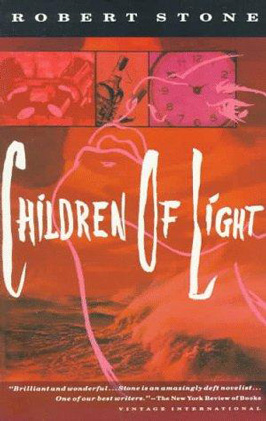
Q: Why can’t I find the film version of The Awakening starring Kate Winslet? I remember seeing the trailer, but when I look for the film, it doesn’t show up anywhere.
A: There is no such film. The trailer you saw is a fake. It was put together by cutting segments of other films and assembling them in a way that makes the imaginary film look almost real.
Q: Is The Awakening available on a CD so I can listen to it as I drive?
A: Yes, there are at least five versions available. You can find them through a library or a bookstore or online. And Reuters and other media outlets are reporting that Audible.com has hired actors to produce “tour de force performances” of new audiobooks. The lineup includes Anne Hathaway reading The Wonderful Wizard of Oz by L. Frank Baum, Colin Firth reading The End of the Affair by Graham Greene, Kate Winslet reading Thérèse Raquin by Émile Zola, Nicole Kidman reading To the Lighthouse by Virginia Woolf, and Kim Basinger reading The Awakening by Kate Chopin.
Commonwealth University of Pennsylvania librarian Sheila Kasperek adds that there are free downloadable audios of The Awakening and some of Chopin’s short stories. They are, she tells us, “done by volunteers, so of varying quality. I’ve listened to others from this site — some great and some just okay. But it’s a cool resource.”
Q: Does anyone have any ideas about how many first editions of The Awakening might be out there?
A (from Chopin scholar Tom Bonner): I do not think that there is a single source to account for existing first editions of any writer’s work in private and institutional collections. Based on antiquarian book e-sites like ABE, the near $10,000 value of first editions of The Awakening suggests that they are rare. Libraries at major research universities may account for 100–120 books. Private collections are hard to estimate, but they are likely fewer than those in institutional collections. Antiquarian book sites vary, but even these number rarely more than three at any given time. Cyril Arnavon’s translation of it–Edna–is in fewer than ten institutional collections in the United States. At Fault is especially rare as it was a paperback edition. Bayou Folk and A Night in Acadie exist in somewhat larger numbers than The Awakening in institutional and private collections as well as at antiquarian book sellers. What I have written here is speculation based on queries that I have made over several years.
For a better sense of Chopin editions, you might consult Robert Skinner and my essay ‘A Rebel in Life and Fiction: Kate Chopin and Her Writings’ in Firsts: The Book Collector’s Magazine (Vol.23, No.2, 2013). The issue is available by mail at Firsts, P.O. Box 65166, Tucson, AZ 85728-5166.
You can read more questions and answers about Kate Chopin and her work, and you can contact us with your questions.
Kate Chopin and Catholicism
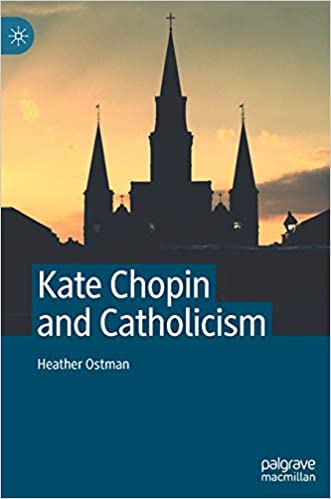
Kate Chopin and Catholicism, a new book by Heather Ostman, has been published by Palgrave Macmillan in London. The publisher’s website describes the book: “This book explores the Catholic aesthetic and mystical dimensions in Kate Chopin’s fiction within the context of an evolving American Catholicism in the late nineteenth and early twentieth centuries. Through a close reading of her novels and numerous short stories, Kate Chopin and Catholicism looks at the ways Chopin represented Catholicism in her work as a literary device that served on multiple levels: as an aesthetic within local color depictions of Louisiana, as a trope for illuminating the tensions surrounding nineteenth-century women’s struggles for autonomy, as a critique of the Catholic dogma that subordinated authenticity and physical and emotional pleasure, and as it pointed to the distinction between religious doctrine and mystical experience, and enabled the articulation of spirituality beyond the context of the Church. This book reveals Chopin to be not only a literary visionary but a writer who saw divinity in the natural world.”
Heather Ostman is president of the Kate Chopin International Society and the editor of three books of Chopin scholarship.
Praeger has published The Historian’s Awakening: Reading Kate Chopin’s Classic Novel as Social and Cultural History (2019), edited by Bernard Koloski. The book is aimed at faculty and students reading Kate Chopin’s novel in its historical context.
It includes a copy of the novel with 200 annotations focused on historical elements. It includes also a preface for teachers, a chronology of historical events relevant to the novel, a guide for pronouncing the names of the novel’s characters, an introductory chapter about Kate Chopin’s life, and a chapter about the historical context of The Awakening, with an emphasis on nineteenth-century social and cultural realities of class, gender, ethnicity, and modernity. At the end is an extensive bibliography and index.
Modern Library Republishes The Awakening with an Introduction by Carmen Maria Machado
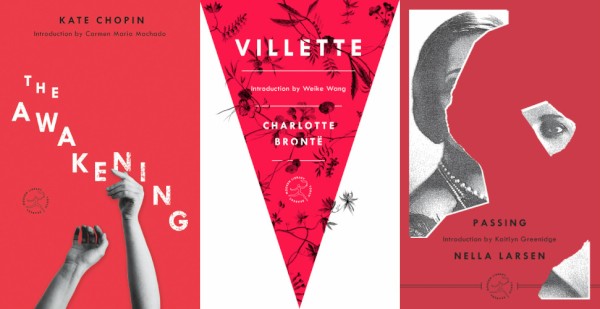
Publisher’s Weekly writes: “The Modern Library will launch a new trade paperback series, Modern Library Torchbearers, this May [2019]. The series, the publisher said, will ‘honor a more inclusive vision of classic books’ by ‘recognizing women who wrote on their own terms, with boldness, creativity, and a spirit of resistance.’
“The books, all previously published, will be repackaged, and each will be introduced by a contemporary woman writer. The inaugural list for the series features . . . The Awakening by Kate Chopin, with an introduction by Carmen Maria Machado (June 18)” along with five other titles.
An earlier (1981) Modern Library version of The Awakening included an influential introduction by Nina Baym.
The 2018 Third Norton Critical Edition of The Awakening
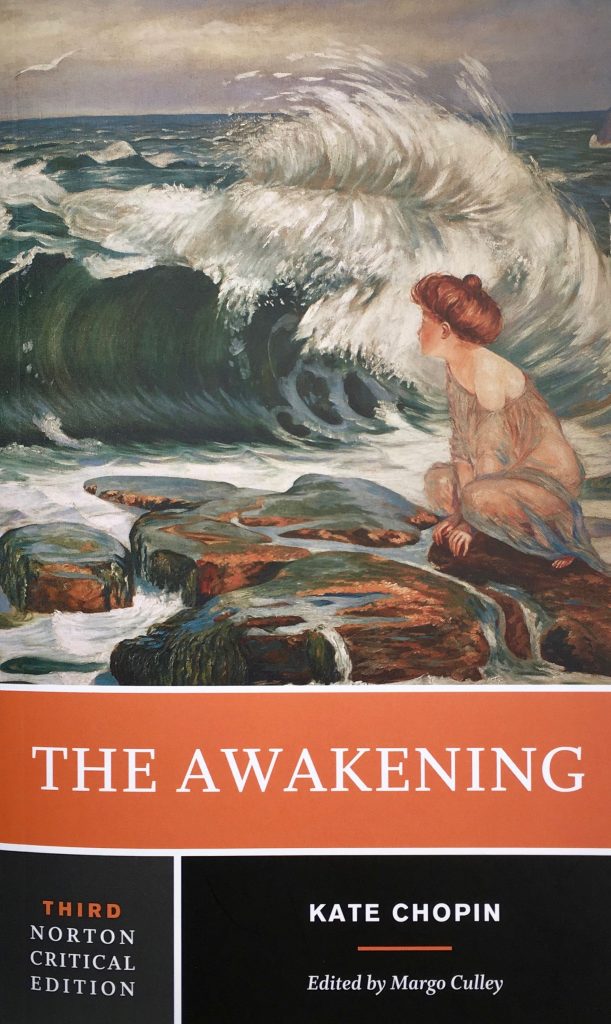
For decades, teachers and scholars have depended upon the Norton Critical Edition of The Awakening. The volume, first published in 1976 and updated in 1994, sold hundreds of thousands of copies and played an important part in establishing Kate Chopin as an essential American author.
Margo Culley’s Third (2018) Norton Critical Edition of The Awakening is now available. It includes excerpts from nine critical essays published since 2000 and from nineteen published before the twenty-first century. It contains updated bibliographies, and it retains its authoritative text, its footnotes, its selections from 1899 reviews, and over two dozen excerpts describing biographical and historical contexts.
The new edition of the Norton will be welcomed by readers in the United States and abroad. As Margo Culley writes in her preface to the volume, Kate Chopin “would be astonished” with the world-wide success of her novel.
For more information about The Awakening
A 2025 MSNBC Broadcast: Velshi Banned Book Club: ‘The Awakening’ by Kate Chopin
The March 15, 2025, MSNBC broadcast notes: “Set in upper-class, patriarchal Louisiana society, ‘The Awakening’ by Kate Chopin is one of the first works of feminist literature in American history. So many of the themes, sentiments, and struggles depicted in this book read as if they could have been written today. But they weren’t. The novel was written in 1899, forcing the reader to confront how much has really changed (or not) for American women in 126 years. Columbia University’s Rachel Adams, who wrote a foreword for an edition to the book, and Erin Entrada Kelly, a Louisiana native and award-winning author, both say that American women’s inability ‘to win’ as a wife, mother, and individual are very much the same.”
A PBS program, “Kate Chopin: A Re-Awakening”
A New Stage Adaptation of The Awakening in San Francisco
The Breadbox, a theater in residence at the Exit Theatre in San Francisco, California, USA, offered a world-premiere stage adaptation of Kate Chopin’s The Awakening. Written by Oren Stevens and developed with director Ariel Craft, it began a three-week run at the Exit on July 29, 2016.
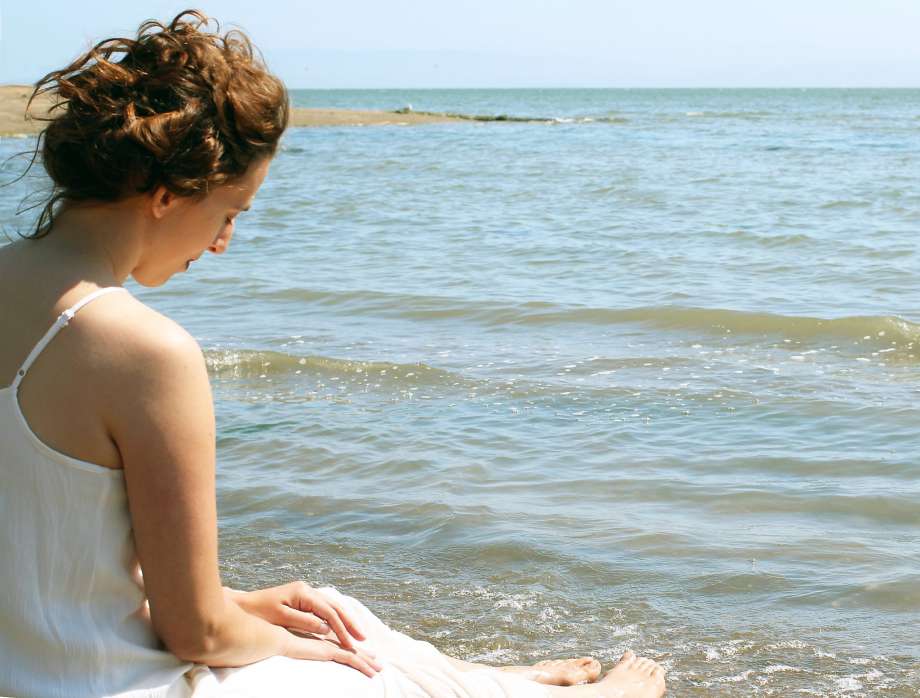
Los Angeles Dance Company Premieres Production Based on The Awakening
The Vaughn Dance Company in Los Angeles premiered on November 7, 2008, an original modern dance production, Reaching Out for the Unlimited, based on Kate Chopin’s novel The Awakening. It featured the music of Grammy-winning composer/guitarist Andrew York.
According to the announcement, “Vaughn Dance Company’s adaptation of The Awakening traces the heroine’s emotional journey, exploring her relationships with friends, lovers, and the sea. Andrew York’s music brings alive the emotional arc of this story with a score that includes new, unpublished pieces and a live performance by York. Making its mark with sensual shapes and undulating movement, Jennifer Vaughn’s choreography is a palpable embodiment of music that captivates broader audiences and dance aficionados alike.”
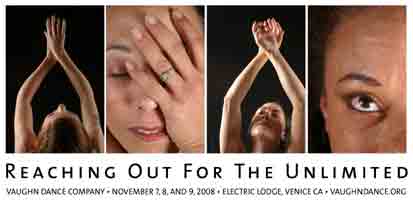
Jennifer Vaughn told us in an email message that her production “traces Edna’s emotional journey, focusing on her complex relationships — with friends, lovers, and with the sea. The company’s ten members embody these roles, including different ‘Ednas’ who change as she discovers new parts of herself. The dancers also become the beckoning sea, the entity which both cradles and emboldens Edna but also sweeps her away.”
She continued, “I chose very simple staging and costuming — very plain and timeless. And for logistical reasons, we chose not to address Edna’s relationship with her children. I believe that audience members who know the story will recognize much of it, but I’ve tried to design the production in such a way that those who do not know the story will still be able to get something out of it.”
A new production of The Awakening was presented by Savage Umbrella and 3AM Productions at Gremlin Theatre in St. Paul, Minnesota, from April 2 to 17, 2010. The script is by Laura Leffler-McCabe, who also directed. The production includes music composed by Candy Bilyk and performed by a trio of instrumentalists, with singing by the cast.
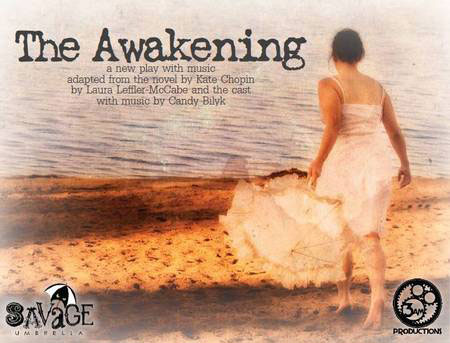
From the announcement for the production:
“‘The book is beautiful,’ Leffler-McCabe says when asked why she decided to take on the project as writer and director. ‘It’s this proto-modernist text full of slice-of-life details and conversations, along with these really lyrical expressive passages of a character in turmoil.’
“The show, which boasts a cast of more than a dozen, was company-created, and incorporates music and movement to do justice to a story that begins in a woman’s heart, then radiates with seismic repercussions into the world around her.
“‘We started workshopping with the cast back in September,’ says Leffler-McCabe. ‘We cussed a lot, fought some, danced, experimented, and honed in on something that gets to the heart of what Chopin was trying to do.'”
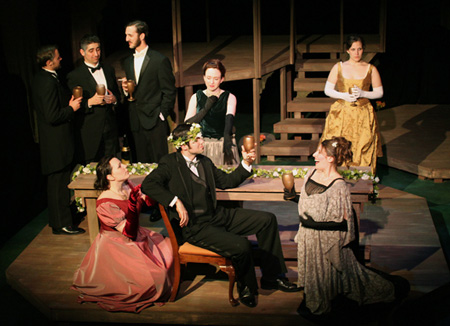
Laura Leffler-McCabe also sent us a performance excerpt. “We put this together for a grant we’re applying for,” she says, “so it’s short and of a sort of strange moment, but it hopefully gives an idea of the style of the production.”
Reading of a New Screenplay Based on The Awakening
New York area residents and visitors attended a reading of a new screenplay based on Kate Chopin’s The Awakening. The screenplay was written by Jim Sherry, the production directed by Joyce Wu.

Photo: “Girl at Sunrise.” Copyright Steve Puntolillo, 2011
The reading was held on June 12th, 2011, at TheaterLab, 137 W. 14th Street New York, NY 10011.
For students and scholars
Accurate printed texts of The Awakening
The Historian’s Awakening: Reading Kate Chopin’s Classic Novel as Social and Cultural History. Edited by Bernard Koloski. Praeger, 2019.
The Norton Critical Edition of The Awakening.Edited by Margo Culley. Norton, third edition, 2018.
The Complete Works of Kate Chopin. Edited by Per Seyersted. Baton Rouge: Louisiana State University Press, 1969, 2006.
Kate Chopin: Complete Novels and Stories. Edited by Sandra Gilbert. New York: Library of America, 2002.
Kate Chopin, The Awakening and Selected Stories. Edited by Sandra Gilbert. Penguin 1984.
Articles and book chapters about The Awakening
Some of the items listed here may be available online through university or public libraries. For items published before 2000, check these listings:
Articles about Kate Chopin published from 1985 through 1999
Articles about Kate Chopin published before 1985
PhD dissertations about Kate Chopin
Duncan, Teddy. “The Inexplicable Real and Silent (Female) Desire: A Lacanian Approach to the Unsaid in The Awakening.” Midwest Quarterly, vol. 64, no. 2, Winter 2023, pp. 186–99.
Putri, Elin Eprilin Fitrian Miela. “Understanding Life and Death Meaning through the Character of Edna Pontelier in Kate Chopin’s the Awakening.” Rubikon: Journal of Transnational American Studies, vol. 10, no. 1, Apr. 2023, pp. 1–11.
Evans, Robert C. “Tolstoy’s Anna Karenina and Kate Chopin’s The Awakening: Comparisons and Contrasts.” Anna Karenina, edited by Robert C. Evans, Salem Press; Grey House Publishing, 2021, pp. 58–74.
Evans, Robert C. “Tolstoy’s Anna Karenina and Kate Chopin’s The Awakening: Responses from 1899.” Anna Karenina, edited by Robert C. Evans, Salem Press; Grey House Publishing, 2021, pp. 3–23.
Francis, Julia. “The Seduction Novel’s Awakening.” Oswald Review, vol. 23, no. 1, Jan. 2021, pp. 63–77.
Kornasky, Linda. “‘Shuddering, Shrinking, Shriveling’: Intimacy and Repulsion in Kate Chopin’s ‘The Unexpected’ and The Awakening.” Studies in American Naturalism, vol. 16, no. 1, Summer 2021, pp. 1–16.
Sönmez Dìnçkan, Yeşim. “Kate Chopin The Awakening Adli Romaninin Türkçeye Çevi̇ri̇si̇nde Hi̇tap Bi̇çi̇mleri̇” [“Forms of Address in the Turkish Translation of The Awakening”] Journal of the Faculty of Letters, vol. 11, no. 22, July 2021, pp. 131–155.
Ferraro, Thomas J. Transgression and Redemption in American Fiction. Oxford University Press, 2020.
Koloski, Bernard. “Kate Chopin.” Oxford Bibliographies in American Literature, edited by Jackson Bryer, Oxford University Press, 2020 [update].
Purdon, Liam. “Symbolic Language and Action in Kate Chopin’s The Awakening.” Mississippi Quarterly, vol. 73, no. 4, Oct. 2020, pp. 549–76.
Băniceru, Cristina. “The Battle of ‘Isms’ in Kate Chopin’s The Awakening.” Romanian Journal of English Studies, vol. 16, no. 1, Nov. 2019, pp. 1–8.
Kang, Meeyoung. “Aesthetics of Desublimation in Kate Chopin’s The Awakening.” Interdisciplinary Literary Studies: A Journal of Criticism and Theory, vol. 21, no. 2, 2019, pp. 238–258.
Kim, Choyeon. “여성 성장소설로서의 각성과 19호실로 : 비극적 결말을 통해 보는 기혼 여성의 성장 / Understanding The Awakening and ‘To Room Nineteen’ as Female Bildungsroman.” Feminist Studies in English Literature, vol. 27, no. 2, 2019, pp. 27–61.
Michalski, Przemysław. “Is Kate Chopin’s The Awakening the American Madame Bovary?” Acta Universitatis Lodziensis. Folia Litteraria Polonica, vol. 49, no.3, 2019, pp. 239-254.
Ramoni, Teresa. “Plaintive Restraints: Facing the Music of Kate Chopin’s The Awakening.” Sigma Tau Delta Review, vol. 16, Jan. 2019, pp. 224–231.
Smith, Amy C., and Julie Wilhelm. “Care and Autonomy in The Awakening and Seo’s ‘Though Time Goes By.’” Mosaic: An Interdisciplinary Critical Journal, vol. 52, no. 1, Mar. 2019, pp. 103–119.
Toth, Emily, “Kate Chopin, Edna Pontellier, and the Predicament of the Intellectual Woman in New Orleans.” New Orleans: A Literary History, edited by T. R. Johnson, Cambridge University Press, 2019, pp. 122-136.
Ehler, Tara. “Reopening the Door to Romance: A Reading of Edna Pontellier.” A Portrait of the Lady in Modern American Literature: Poor Little Rich Girl, edited by Aimee Pozorski and M. J. Martinez, Cambridge Scholars Publishing, 2018, pp. 33–43.
Kanzler, Katja. “Kate Chopin, The Awakening(1899).” Handbook of the American Novel of the Nineteenth Century, edited by Christine Gerhardt, Walter de Gruyter Publishing, 2018, pp. 543–558.
Salinas, Shanna M. “Coloring the U.S.-Mexico Border Geographical Othering and Postbellum Nation Building in Kate Chopin’s The Awakening.” Studies in American Fiction, vol. 45, no. 1, Spring 2018, pp. 39–60.
Treu, Robert. “Surviving Edna: A Reading of the Ending of The Awakening.” A Portrait of the Lady in Modern American Literature: Poor Little Rich Girl, edited by Aimee Pozorski and M. J. Martinez, Cambridge Scholars Publishing, 2018, pp. 44–60.
Khoshnood, Ali. “Kate Chopin’s The Awakening: An Exploration of Edna Pontellier’s Transition during Her Mid-Life Crisis.” Neohelicon, vol. 44, 2017, pp. 563-581. [doi: 10.1007/s11059-017-0388-7.]
Kumlu, Esin. “Explicating Female Body as a Geography of Memory: The Comparative Silent Rebellion of the Psyche in Chopin and Hawthorne.” Folklor/Edebiyat: Halkbilim, Etnoloji, Antropoloji, Edebiyat, vol. 23, no. 90, 2017, pp. 97–112.
Tercan, Burcu. “The Story of a Woman Trapped between the Imaginary and Symbolic Orders in Kate Chopin’s The Awakening.” International Journal of Arts & Sciences, vol. 9, no. 4, Jan. 2017, pp. 679–682.
George, Jessica Bridget. ““The Whole Island Seems Changed”: A Bioregional Approach to Kate Chopin’s Fiction.” Journal of the Midwest Modern Language Association, vol. 49, no. 1, 2016, pp. 25–51.
Hildebrand, Molly J. “The Masculine Sea: Gender, Art, and Suicide in Kate Chopin’s the Awakening.” American Literary Realism, vol. 48, no. 3, 2016, pp. 189–208.
Hwang, Namyeob. “Edna’s Revolt through the Homosexual Disposition: The Awakening.” Feminist Studies in English Literature, vol. 24, no. 1, 2016, pp. 67–97.
Rooks, Amanda Kane. “Reconceiving the Terrible Mother: Female Sexuality and Maternal Archetypes in Kate Chopin’s The Awakening.” Women’s Studies, vol. 45, Jan–June 2016, pp. 122–41.
Zibrak, Arielle. “Kissing a Photograph: Reproductive Panic in Kate Chopin and Thomas Hardy.” Criticism: A Quarterly for Literature and the Arts, vol. 58, no. 3, 2016, pp. 355–374.
Bonner, Thomas, Jr. “Edna, Cyrille Arnavon’s Translation of Kate Chopin’s The Awakening: Publication Dates and History.” ANQ vol. 28, 2015, pp. 56–57.
Crowley, John William. “Kate Chopin, Frédéric Chopin, and the Music of the Future.” American Literary Realism, vol. 47, 2015, pp. 95–116.
George, Sarah Forest. “A Vanishing Act: The Invisible Quadroons of Chopin’s The Awakening.” Ethos: A Digital Review of Arts, Humanities, and Public Events, vol. 2, no. 1, 2015, pp. 38–47.
Pflueger, Pennie. “The Piano and Female Subjectivity: Kate Chopin’s The Awakening (1899) and Jane Campion’s The Piano (1993).” Women’s Studies: An Interdisciplinary Journal, vol. 44, no. 4, June 2015, pp. 468–498.
Sedehi, Kamelia Telebian, et al. “Subjectivity, Individuality and Abjection in Kate Chopin’s the Awakening.” International Journal of Comparative Literature and Translation Studies, vol. 3, no. 4, 2015, pp. 14–19.
McConnell, Mikaela. “A Lost Sense Of Self By Ignoring Other In The Awakening By Kate Chopin.” Explicator 72.1 (2014): 41–44.
Articles in Evans, Robert C. Critical Insights: The Awakening. Ipswich, MA: Salem, 2014:
Koloski, Bernard. “On The Awakening.” [How to Understand Edna Pontellier]: 2–15.
Rottgering, Courtney. “Biography of Kate Chopin”: 16–23.
Ulin, Julieann Veronica. “The Awakening and Impressionism”: 24–39.
Bray, Stephen Paul, and Sarah Fredericks, “The Chief Characters in The Awakening”: 40–58.
Evans, Robert C. “Surprises, Complications, Shifts, and Juxtapositions”: 59–73.
—. “Mark Twain, Kate Chopin, Huckleberry Finn”: 74–87.
—. “Was The Awakening Banned or Burned?”: 90–111.
Dyer, Joyce. “A Letter to Students as They Read The Awakening”: 112–29.
Evans, Robert C. “Defending The Awakening”: 130–45.
—. “In Defense of Robert Lebrun”: 146–61.
Melton, Jeffrey. “Tourism and Landscape in The Awakening.” 162–75.
Bonner, Thomas, Jr. “Kate Chopin’s The Awakening as Travel Literature.” 176–89.
Papke, Mary E. “Reading Chopin Reading.” 190–204.
Arner, Robert D. “Gendered Discourse in The Awakening.” 205–16.
Evans, Robert C. “Humor in The Awakening.” 217–31.
Ramos, Peter J. “The Awakening as a Cautionary Tale.” 232–45.
Wehner, David Z. “Reading The Awakening through Kate Chopin.” 246–60.
Beer, Janet, and Helena Goodwyn. “The Awakening: Authenticity and the Artist.” 261–74.
Franklin, Rosemary F. “Chopin’s The Awakening: A Semiotic Novel.” PSYART: 17 August 2011. Web. 26 Sept. 2011.
Davis,William A. Jr. “Female Self–Sacrifice in Kate Chopin’s The Awakening: Conflict and Context.” Notes and Queries 58.4 (2011): 563–67.
Kornasky, Linda. “‘Discovery Of A Treasury’: Orrick Johns and the Influence of Kate Chopin’s The Awakening on Edith Summers Kelley’s Weeds.” Studies In American Naturalism 6.2 (2011): 197–215.
Mou, Xianfeng. “Kate Chopin’s Narrative Techniques and Separate Space in The Awakening.” Southern Literary Journal 44.1 (2011): 103–20.
Tas, Mehmet Recep. “Kate Chopin’s The Awakening in the Light of Freud’s Structural Model of the Psyche.” Uluslararas Sosyal Arastrmalar Dergisi/Journal of International Social Research 4.19 (2011): 413–18.
Wehner, David Z. ” ‘A Lot Up for Grabs’: The Idiosyncratic, Syncretic Religious Temperament of Kate Chopin.” American Literary Realism 43.2 (2011): 154–68.
Mainland, Catherine. “Chopin’s Bildungsroman: Male Role Models in The Awakening.” Mississippi Quarterly 64.1–2 (2011): 75–85.
Witherow, Jean. ” ‘Abysses of Solitude’: Chopin’s Intertextuality with Flaubert.” Mississippi Quarterly 64.1–2 (2011): 87–113.
Ramos, Peter. “Unbearable Realism: Freedom, Ethics and Identity in The Awakening.” College Literature 37.4 (2010): 145–65.
Freeman, Barbara Claire. “The Awakening: Waking Up at the End of the Line.” The Sublime. 1-26. New York, NY: Bloom’s Literary Criticism, 2010.
Kohn, Robert E. “Edna Pontellier Floats into the Twenty-First Century.” Journal of Popular Culture 43.1 (2010): 137-155.
Stuffer, Deidre. “Edna Pontellier’s Strip Tease of Essentiality: An Examination of the Metaphorical Role of Clothing in Kate Chopin’s The Awakening.” Sigma Tau Delta Review 7. (2010): 116-123.
Brown, Kathleen L., and Peter Lev. Teaching Literary Theory Using Film Adaptations Jefferson, NC: McFarland, 2009.
Dix, Andrew, and Lorna Piatti. “‘Bonbons in Abundance’: The Politics of Sweetness in Kate Chopin’s Fiction.” Culinary Aesthetics and Practices in Nineteenth-Century American Literature. 53-69. New York, NY: Palgrave Macmillan, 2009.
Evans, Robert C. “Renewal and Rebirth in Kate Chopin’s The Awakening.” Rebirth and Renewal. 13-24. New York, NY: Bloom’s Literary Criticism, 2009.
Hebert-Leiter, Maria. “The Awakening Awakened.” In Becoming Cajun, Becoming American: The Acadian in American Literature from Longfellow to James Lee Burke, 57–78. Baton Rouge: LSU Press, 2009.
Miyagawa, Chiori. “A Mystical Place Called Grand Isle: Adapting Kate Chopin’s The Awakening.” Feminist Theatrical Revisions of Classic Works: Critical Essays. 204-214. Jefferson, NC: McFarland, 2009.
Pettersson, Bo. “Narratology and Hermeneutics: Forging the Missing Link.” Narratology in the Age of Cross-Disciplinary Narrative Research. 11-34. Berlin, Germany: de Gruyter, 2009.
Batinovich, Garnet Ayers. “Storming the Cathedral: The Antireligious Subtext in Kate Chopin’s Works.” Kate Chopin in the Twenty-First Century: New Critical Essays. 73-90. Newcastle upon Tyne, England: Cambridge Scholars, 2008.
Camastra, Nicole. “Venerable Sonority in Kate Chopin’s The Awakening.” American Literary Realism 40.2 (Winter 2008): 154-166.
Castillo, Susan. “‘Race’ and Ethnicity in Kate Chopin’s Fiction.” The Cambridge Companion to Kate Chopin. 59-72. Cambridge, England: Cambridge UP, 2008.
Chang, Li-Wen. “The Awakening: Chopin’s Reading of Leisure-Class Women in Ourland.” Kate Chopin in the Twenty-First Century: New Critical Essays. 137-157. Newcastle upon Tyne, England: Cambridge Scholars, 2008.
Clark, Zoila. “The Bird That Came Out of the Cage: A Foucauldian Feminist Approach to Kate Chopin’s The Awakening.” Journal for Cultural Research 12.4 (Oct. 2008): 335-347.
González Groba, Constante. On Their Own Premises: Southern Women Writers and the Homeplace Valencia, Spain: Universitat de València, 2008.
Heilmann, Ann. “The Awakening and New Woman Fiction.” The Cambridge Companion to Kate Chopin. 87-104. Cambridge, England: Cambridge UP, 2008.
Horner, Avril. “Kate Chopin, Choice and Modernism.” The Cambridge Companion to Kate Chopin. 132-146. Cambridge, England: Cambridge UP, 2008.
Joslin, Katherine. “Kate Chopin on Fashion in a Darwinian World.” The Cambridge Companion to Kate Chopin. 73-86. Cambridge, England: Cambridge UP, 2008.
Knights, Pamela. “Kate Chopin and the Subject of Childhood.” The Cambridge Companion to Kate Chopin. 44-58. Cambridge, England: Cambridge UP, 2008.
Koloski, Bernard. “The Awakening: The First 100 Years.” The Cambridge Companion to Kate Chopin. 161-173. Cambridge, England: Cambridge UP, 2008.
Liu, Hongwei. “Lun li huan jing yu xiao shuo Jue xing de ju jue yu jie shou.” Foreign Literature Studies/Wai Guo Wen Xue Yan Jiu 30.6 [134] (2008): 71-75.
Nisetich, Rebecca. “From ‘Shadowy Anguish’ to ‘The Million Lights of the Sun’: Racial Iconography in Kate Chopin’s The Awakening.” Kate Chopin in the Twenty-First Century: New Critical Essays. 121-136. Newcastle upon Tyne, England: Cambridge Scholars, 2008.
Nolan, Elizabeth. “The Awakening as Literary Innovation: Chopin, Maupassant and the Evolution of Genre.” The Cambridge Companion to Kate Chopin. 118-131. Cambridge, England: Cambridge UP, 2008.
Taylor, Helen. “‘The Perfume of the Past’: Kate Chopin and Post-Colonial New Orleans.” The Cambridge Companion to Kate Chopin. 147-160. Cambridge, England: Cambridge UP, 2008.
Thrailkill, Jane F. “Chopin’s Lyrical Anodyne for the Modern Soul.” Kate Chopin in the Twenty-First Century: New Critical Essays. 33-52. Newcastle upon Tyne, England: Cambridge Scholars, 2008.
Toth, Emily. “What We Do and Don’t Know About Kate Chopin’s Life.” The Cambridge Companion to Kate Chopin. 13-26. Cambridge, England: Cambridge UP, 2008.
Worton, Michael. “Reading Kate Chopin Through Contemporary French Feminist Theory.” The Cambridge Companion to Kate Chopin. 105-117. Cambridge, England: Cambridge UP, 2008.
Zaugg, Brigitte. “Kate Chopin and Ellen Glasgow: Between Visibility and Oblivion.” Résonances 10 (Oct. 2008): 179-202.
Koloski, Bernard. “Kate Chopin: The Critics, the Librarians, and the Scholars.” Popular Nineteenth-Century American Women Writers and the Literary Marketplace. 451-465. Newcastle upon Tyne, England: Cambridge Scholars, 2007.
Streater, Kathleen M. “Adèle Ratignolle: Kate Chopin’s Feminist at Home in The Awakening.” Midwest Quarterly 48 (2007): 406-416.
Witherow, Jean Adams. “‘To Love a Little and Then to Die!’: Chopin Awakens Emma Bovary.” Southern Studies: An Interdisciplinary Journal of the South 14.2 (2007): 29-48.
Bloom, Lynn Z. “The Dinner Hours.” CEA Critic: An Official Journal of the College English Association 69.1-2 (2006-2007 Fall-Winter 2006): 3-13.
Church, Joseph. “An Abuse of Art in Chopin’s The Awakening.” American Literary Realism 39.1 (Fall 2006): 20-23.
Frye, Katie Berry. “Edna Pontellier, Adèle Ratignolle, and the Unnamed Nurse: A Triptych of Maternity in The Awakening.” Southern Studies 13.3-4 (2006): 45-66.
Gaskill, Nicholas M. “‘The Light Which, Showing the Way, Forbids It’: Reconstructing Aesthetics in The Awakening.” Studies in American Fiction 34.2 (2006): 161-188.
Heuston, Sean. “Chopin’s The Awakening.” Explicator 64 (2006): 220-223.
Johnson, Steven K. “Uncanny Burials: Post-Civil War Memories in Chopin and Bierce.” ABP Journal 2.1 (Fall 2006).
Parmiter, Tara K. “Taking the Waters: The Summer Place and Women’s Health in Kate Chopin’s The Awakening.” American Literary Realism 39.1 (Fall 2006): 1-19.
Pierse, Mary S. “Paris as ‘Other’: George Moore, Kate Chopin and French Literary Escape Routes.” ABEI Journal: The Brazilian Journal of Irish Studies 8 (June 2006): 79-87.
Wasserstrom, Jeffrey N. “Searching for Emily Hahn on the Streets of St Louis.” History Workshop Journal 61 (Spring 2006): 214-221.
Witherow, Jean. “Kate Chopin’s Dialogic Engagement with W. D. Howells: ‘What Cannot Love Do?’.” Southern Studies: An Interdisciplinary Journal of the South 13.3-4 (2006 Fall-Winter 2006): 101-116.
Bradley, Patricia L. “The Birth of a Tragedy and The Awakening: Influences and Intertexualities.” Southern Literary Journal 37 (2005): 40-61.
Despain, Max and Thomas Bonner, Jr. “Shoulder to Wings: The Provenance of Winged Imagery from Kate Chopin’s Juvenilia Through The Awakening.” Xavier Review 25.2 (2005): 49-64.
Felder, Deborah G. A Bookshelf of Our Own: Works That Changed Women’s Lives New York: Citadel, 2005.
Margraf, Erik. “Kate Chopin’s The Awakening as a Naturalistic Novel.” American Literary Realism 37.2 (2005): 93-116.
Parvulescu, Anca. “To Die Laughing and to Laugh at Dying: Revisiting The Awakening.” New Literary History 36 (2005): 477-495.
Richter, Eva, and Bailin Song. “Translating the Concept of ‘Identity’.” Translation and Cultural Change: Studies in History, Norms and Image-Projection. 91-110. Amsterdam, Netherlands: Benjamins, 2005.
White, Roberta. A Studio of One’s Own: Fictional Women Painters and the Art of Fiction Madison, NJ: Fairleigh Dickinson UP, 2005.
Biggs, Mary. “‘Si tu savais’: The Gay/Transgendered Sensibility of Kate Chopin’s The Awakening.” Women’s Studies 33 (2004): 145-181.
Davis, Doris. “The Enigma at the Keyboard: Chopin’s Mademoiselle Reisz.” Mississippi Quarterly 58.1-2 (2004): 89-104.
Dunphy, Mark. “New England Transcendental Gumbo: Edna Pontellier’s Awakening to Emersonian Self-Reliance in The Awakenin.” Emerson at 200. 153-160. Rome, Italy: Aracne, 2004.
Martinez, Inez. “Reading for Psyche: Kate Chopin’s The Awakening.” Harvest: International Journal for Jungian Studies 50 (2004): 105-119.
Mikolchak, Maria. “Kate Chopin’s The Awakening as Part of the Nineteenth-Century American Literary Tradition.” Interdisciplinary Literary Studies 5 (2004): 29-49.
Sielke, Sabine. “‘Rowing in Eden’ and Related Waterway Adventures: Seaward Visions in American Women’s Writing.” The Sea and the American Imagination. 111-134. Tübingen, Germany: Stauffenburg, 2004.
Singer, Sandra. “Awakening the Solitary Soul: Gendered History in Women’s Fiction and Michael Cunningham’s The Hours.” Doris Lessing Studies 23 (2004): 9-12.
Xue, Mei. “Destiny of ‘the Second Sex’: A Study of the Heroine in The Awakening.” Re-Reading America: Changes and Challenges. 363-371. Cheltenham, England: Reardon, 2004.
Birnbaum, Michele. Race, Work, and Desire in American Literature, 1860-1930 Cambridge, England: Cambridge UP, 2003.
Boynton, Victoria. “Writing Women, Solitary Space and the Ideology of Domesticity.” Herspace: Women, Writing, and Solitude. 147-164. New York: Haworth, 2003.
Elz, A. Elizabeth. “The Awakening and A Lost Lady: Flying with Broken Wings and Raked Feathers.” Southern Literary Journal 35 (2003): 13-27.
Jones, Paul Christian. “A Re-Awakening: Anne Tyler’s Postfeminist Edna Pontellier in Ladder of Years.” Critique 44 (2003): 271-283.
Kinnison, Dana. “Female Resistance to Gender Conformity in Kate Chopin’s The Awakening.” Women in Literature: Reading through the Lens of Gender. 22-25. Westport, CT: Greenwood, 2003.
Rich, Charlotte. “Reconsidering The Awakening: The Literary Sisterhood of Kate Chopin and George Egerton.” Southern Quarterly 41 (2003): 121-136.
Valkeakari, Tuire. “A ‘Cry of the Dying Century’: Kate Chopin, The Awakening, and the Women’s Cause.” NJES: Nordic Journal of English Studies 2 (2003): 193-216.
Varley, Jane, and Aimee Broe Erdman. “Working for Judith Shakespeare: A Study in Feminism.” Midwest Quarterly 44 (2003): 266-281.
Disheroon-Green, Suzanne. “Mr. Pontellier’s Cigar, Robert’s Cigarettes: Opening the Closet of Homosexuality and Phallic Power in The Awakening‘.” Songs of Reconstructing South: Building Literary Louisiana, 1865-1945. 183-195. Westport, CT: Greenwood, 2002.
——-. “Whither Thou Goest, We Will Go: Lovers and Ladies in The Awakening.” Southern Quarterly 40 (2002): 83-96.
Dyer, Joyce. “Reading The Awakening with Toni Morrison.” Southern Literary Journal 35 (2002): 138-154.
Maguire, Roberta S. “Kate Chopin and Anna Julia Cooper: Critiquing Kentucky and the South.” Southern Literary Journal 35 (2002): 123-137.
Mathews, Carolyn L. “Fashioning the Hybrid Woman in Kate Chopin’s The Awakening.” Mosaic 35 (2002): 127-149.
Petruzzi, Anthony P. “Two Modes of Disclosure in Kate Chopin’s The Awakening.” Lit: Literature Interpretation Theory 13 (2002): 287-316.
Strozier, Robert. “Interiority, Identity, Knowledge: Unraveling the Cartesian Cogito.” Thresholds of Western Culture: Identity, Postcoloniality, Transnationalism. 14-31. New York: Continuum, 2002.
Asbee, Sue. “The Awakening: Contexts.” The Nineteenth-Century Novel: Identities. 269-286. London, England: Open UP; Routledge, 2001.
——-. “The Awakening: Identities.” The Nineteenth-Century Novel: Identities. 242-268. London, England: Open UP; Routledge, 2001.
Bunch, Dianne. “Dangerous Spending Habits: The Epistemology of Edna Pontellier’s Extravagant Expenditures in The Awakening.” Mississippi Quarterly 55 (2001): 43-61.
Green, Suzanne Disheroon. “Awakening the ‘Essence of Blue’: The Emerging Southern Women of Kate Chopin and Moira Crone.” Songs of the New South: Writing Contemporary Louisiana. 143-151. Westport, CT: Greenwood, 2001.
Pizer, Donald. “A Note on Kate Chopin’s The Awakening as Naturalistic Fiction.” Southern Literary Journal 33 (2001): 5-13.
Walker, Nancy A. Kate Chopin: A Literary Life Basingstoke, England: Palgrave, 2001.
Araújo, Helena. “Marvel Moreno, ¿modernista?.” Literatura y cultura: Narrativa colombiana del siglo XX, I: La nación moderna: Identidad; II: Diseminación, cambios, desplazamientos; III: Hibridez y alteridades. 168. Bogotá, Colombia: Ministerio de Cultura, 2000
Barrish, Phillip. “The Awakening‘s Signifying ‘Mexicanist’ Presence.” Studies in American Fiction 28 (2000): 65-76.
Bartley, William. “Imagining the Future in The Awakening.” College English 62 (2000): 719-746.
Faraudo, Rosario. “El trágico vuelo de Icaro. Entramado mitológico y simbólico que subyace en The Awakening de Kate Chopin.” Anuario de Letras Modernas 10 (2000): 43-50.
Heynitz, Benita von. “Kate Chopin’s The Awakening and Richard Wagner’s Musical Concepts.” English in the Modern World. 57-67. Frankfurt, Germany: Peter Lang, 2000.
Lippincott, Gail. “Thirty-Nine Weeks: Pregnancy and Birth Imagery in Kate Chopin’s The Awakening.” This Giving Birth: Pregnancy and Childbirth in American Women’s Writing. 55-66. Bowling Green, OH: Popular, 2000.
McGee, Diane. “The Structure of Dinners in Kate Chopin’s The Awakening.” Proteus 17 (2000): 47-51.
Treu, Robert. “Surviving Edna: A Reading of the Ending of The Awakening.” College Literature 27 (2000): 21-36.
Yoon, Junggil. “[The Significance of Music in Kate Chopin’s The Awakening].” Journal of English Language and Literature/Yongo Yongmunhak 46 (2000): 507-527.
Selected books that discuss The Awakening.
Ferraro, Thomas J. Transgression and Redemption in American Fiction. Oxford UP, 2020.
Fretwell, Erica. Sensory Experiments: Psychophysics, Race, and the Aesthetics of Feeling. Duke UP, 2020.
Ostman, Heather. Kate Chopin and Catholicism. Palgrave Macmillan, 2020.
Humburg, Jasmin. Television and Precarity: Naturalist Narratives of Poor America. J.B. Metzler/Springer-Verlag, 2019.
Koloski, Bernard, ed. The Historian’s Awakening: Reading Kate Chopin’s Classic Novel as Social and Cultural History. Praeger, 2019.
Skaris, Katherine. Affective Labour in British and American Women’s Fiction, 1848-1915. Cambridge Scholars, 2018.
Peiu, Anca Romantic Renderings of Selfhood in Classic American Literature. Editura C. H. Beck, 2017
Randall, Kelli V. American Realist Fictions of Marriage: From Kate Chopin, Edith Wharton to Frances Harper, Pauline Hopkins. Peter Lang, 2017.
Ostman, Heather, and Kate O’Donoghue, eds. Kate Chopin in Context: New Approaches. Palgrave Macmillan, 2015.
Evans, Robert C. The Awakening. Salem, 2014.
Prenshaw, Peggy Whitman. Composing Selves: Southern Women and Autobiography. Louisiana State UP, 2011.
Koloski, Bernard, ed. Awakenings: The Story of the Kate Chopin Revival. Louisiana State UP, 2009, 2012.
Beer, Janet, ed. The Cambridge Companion to Kate Chopin. Cambridge UP, 2008.
Bloom, Harold, ed. Kate Chopin’s The Awakening. Chelsea House, 2008.
Ostman, Heather. Kate Chopin in the Twenty-First Century: New Critical Essays. Cambridge Scholars, 2008.
Toth, Emily. Unveiling Kate Chopin. UP of Mississippi, 1999.
Petry, Alice Hall (ed.), Critical Essays on Kate Chopin. G. K. Hall, 1996.
Elfenbein, Anna Shannon. Women on the Color Line: Evolving Stereotypes and the Writings of George Washington Cable, Grace King, Kate Chopin. UP of Virginia, 1994.
Keesey Donald, The Awakening: Contexts for Criticism. Mayfield, 1994.
Dyer, Joyce. The Awakening: A Novel of Beginnings. Twayne, 1993.
Walker, Nancy. Kate Chopin: The Awakening (in the Case Studies in Contemporary Criticism series). St. Martins, 1993.
Boren, Lynda S. and Sara deSaussure Davis (eds.), Kate Chopin Reconsidered: Beyond the Bayou. Louisiana State UP, 1992.
Hoder-Salmon, Marilyn. Kate Chopin’s The Awakening: Screenplay As Interpretation. University Press of Florida, 1992.
Perspectives on KateChopin: Proceedings from the Kate Chopin International Conference, April 6, 7, 8, 1989. Northwestern State UP, 1992.
Papke, Mary E. Verging on the Abyss: The Social Fiction of Kate Chopin and Edith Wharton. Greenwood, 1990.
Toth, Emily. Kate Chopin. Morrow, 1990.
Elfenbein , Anna Shannon. Women on the Color Line: Evolving Stereotypes and the Writings of George Washington Cable, Grace King, Kate Chopin. UP of Virginia, 1989.
Taylor, Helen. Gender, Race, and Region in the Writings of Grace King, Ruth McEnery Stuart, and Kate Chopin. Louisiana State UP, 1989.
Bonner, Thomas Jr., The Kate Chopin Companion. Greenwood, 1988.
Koloski, Bernard (ed.), Approaches to Teaching Chopin’s The Awakening. Modern Language Association, 1988.
Martin, Wendy (ed.), New Essays on The Awakening. Cambridge UP, 1988.
Bloom, Harold (ed.), Kate Chopin. Chelsea, 1987.
Ewell, Barbara C. Kate Chopin. Ungar, 1986.
Skaggs, Peggy. Kate Chopin. Twayne, 1985.
Seyersted, Per. Kate Chopin: A Critical Biography. Louisiana State UP, 1969.
Arnavon, Cyrille (trans.), Edna. Club Bibliophile de France, 1953.
Rankin, Daniel, Kate Chopin and Her Creole Stories. U of Pennsylvania P, 1932.

